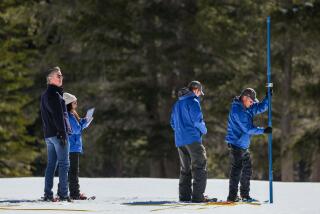More Rainwater In Itself Is No Long-Term Solution : Why the water crisis in California is so very slippery when wet
- Share via
WHAT HAPPENED LAST WEEK: As the stereotype goes, rainy weather is both good news and bad. A Californian is asked how the state should solve its water problem. Turning on the tap and watching water spill out, the Californian asks: What problem? Too often before the current drought that began in 1987, the stereotype had a certain ring of truth. So, can the people of California and their political leaders, currently in their fifth year of drought, stand the prosperity of precipitation?
We are about to find out, after a month of storms snatched a drought from crisis and downgraded it into a mere drought emergency. Despite March downpours that produced floods in the midst of what still will go into the books as a drought year, most reservoirs hold little more than half the water they should. Even so, the state needed help from an Easterner, Sen. Bill Bradley (D-N.J.), on a long-term plan for drought management. On its own last week, Sacramento talked mainly of releasing more water soon for Southern California but not about the hard decisions needed to protect the state from water shortages even in wet years.
WHAT’S STILL TO BE DONE: Water managers have known for some years that California’s booming growth was leaving the state’s gigantic water delivery system of dams and aqueducts in the dust. Growth in other Western states drained off some of California’s supplies. Broader concerns for the environment have meant giving some back to nature.
But since the mid-1980s, the agencies responsible for distributing water to 30 million Californians have had no better luck getting attention from citizens or action from politicians than in getting a few years of normal rainfall. Only the drought finally got the attention of citizens, particularly in places like Santa Barbara, where rigid rationing has been in effect for a year. So far, Gov. Pete Wilson and his drought team have done a good job of day-to-day crisis management.
A GOOD IDEA: Last week Sen. Bradley contributed a creative plan to make water from the federal government’s Central Valley Project available for sale by farmers to cities or other farmers on terms similar to those Wilson is encouraging in the smaller State Water Project.
In a normal year, the federal project delivers about 8 million acre-feet of water, mostly to San Joaquin Valley farms. (An acre-foot is enough to last a family of five for 18 months.) The state project delivers about 2.3 million acre-feet, half to valley farms and the other half to Southern California, so that Sacramento’s experiment in buying and selling water as it might oil or electricity is limited to a relatively small part of the state’s total water supply.
Californians got their first close look at the Bradley concept during hearings in Los Angeles last week. What the senator proposed here is a reform of the Central Valley Project. Project managers would hold back water to restore fisheries and wetlands that have been damaged by transfers of water to irrigation. More to the point of California’s drought, the project would operate more in line with what Bradley calls the “progressive and forward-looking” water law in California. That would mean, among other things, allowing parched cities in future drought years to purchase water from Central Valley farmers, now forbidden by federal law.
BEYOND THE CRISIS: Water marketing as a drought management tool has a foothold in California and will grow. What Sacramento now must focus on is the more distant but no less urgent fact that California has outgrown all of its water projects, even for years with normal rainfall. By one estimate, the state is short by as much as 1.4 million acre-feet of water, more than Southern California gets from the State Water Project. Other estimates are higher.
Yet Sacramento has no master plan for its water future, so recently revealed as fragile indeed for a state whose gross income is higher than that of most independent nations. There is talk of bits and pieces of new projects, such as Los Banos Grande, a new reservoir west of the California aqueduct, to store more heavy winter runoff. And adding 200 feet to the height of Shasta Dam would expand the reservoir enough to yield the 1.4 million acre-feet by which the state is now short. But the capital costs for both projects are so high that water agencies don’t want to talk about it now.
The master plan should not be a construction plan entirely. It could include a plan for systematic buying-up of farmland and its water rights, as Arizona is doing, to free the water for urban areas. Such an approach might include some limits on growth.
This would be politically savage, but California lives today in an emergency it created by a decade-long vacation from hard thinking about the future. Every day of the 1991 drought that slips by without an effort to make up for lost time moves the state closer to the next drought.
More to Read
Sign up for Essential California
The most important California stories and recommendations in your inbox every morning.
You may occasionally receive promotional content from the Los Angeles Times.










